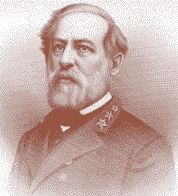
|

|
Michael Feldberg
The Jewish artist encouraged by Gen. Robert E. Lee
http://www.jewishworldreview.com --
ONE of the most striking monuments in Arlington National
Cemetery is the Confederate Memorial. Commissioned by
the United Daughters of the Confederacy, it was
designed and executed by Sir Moses Jacob Ezekiel
(1844-1917) of Richmond, Virginia, the first great
American Jewish sculptor, who was living in Rome.
Ezekiel was 16 when Fort Sumter was attacked in 1861.
An ardent believer in states' rights, Ezekiel begged his
parents to allow him to enroll at the Virginia Military
Institute. They consented, and he became the first Jew
to attend VMI. Three years later, when the cadets were
summoned to aid Confederate General John C.
Breckenridge at the Battle of New Market, Virginia,
Ezekiel joined the cadet's charge against Union lines.
When the war ended, Ezekiel completed his studies at
VMI and graduated in 1866. According to Ezekiel's
memoirs and letters, which repose at the American
Jewish Historical Society, Ezekiel met General Robert E.
Lee during this period. Lee counseled Ezekiel, "I hope you
will be an artist … and do earn a reputation in whatever
profession you undertake."
Living up to Lee's injunction, Ezekiel won worldwide fame
as a sculptor. Had he been born a century earlier, Ezekiel
would almost certainly never have become a sculptor at
all. Until the early 1800s in America, the phrase "Jewish
artist" was an oxymoron. American Jewish painters were
rare and Jewish sculptors rarer still because of the
Second Commandment's prohibition against making
images. By the time Ezekiel was born in 1844, however,
most American rabbis interpreted the Commandment to
mean that Jews should not worship graven images, as
opposed to painting or sculpting them. By the 1860s,
Ezekiel was free to give three-dimensional expression to
his Judaism without violating his faith.
Judaism was a major theme of Ezekiel's art. At age 13, he
executed a bust of "Cain Receiving the Curse of the
Almighty." His second work, "Moses Receiving the Law on
Mount Sinai," collapsed during a storm, which disaster his
grandmother, who remained a Second Commandment
strict constructionist, attributed to divine justice.
In the late 1860's, Ezekiel studied painting and sculpture
in Cincinnati and Berlin. In the latter city, his bas-relief
"Israel" won a prestigious prize that enabled him to study
in Rome. One critic, who took note of the fact that the
talented young winner was a Jew, expressed the hope
that Ezekiel "would disprove the prevailing notion that
the race of Shem has no genius for the plastic arts."
Ezekiel became an expatriate, living in Rome for more
than 40 years. Nonetheless, his most important sculpture
commissions were for works erected in the United States.
In 1876, the Independent Order of B'nai B'rith asked
Ezekiel to create an allegorical sculpture of "Religious
Liberty" for the Philadelphia Centennial Exposition. The
resulting marble statue, featuring an eight-foot tall
woman wearing a coat of mail against the shaft of
tyranny, now stands outside the National Museum of
American Jewish History in Philadelphia.
Ezekiel's work also adorns the Corcoran Gallery in
Washington, D.C. and the Confederate Cemetery at
Johnson's Island, Ohio, among other sites, and he
designed the seal of the Jewish Publication Society of
America. In 1899, Rabbi Isaac Mayer Wise, the leader of
American Reform Judaism and founder of Hebrew Union
College in Cincinnati, posed for Ezekiel. Ezekiel's father
Jacob was the first secretary to the Board of Governors
of HUC.
Ezekiel did indeed "earn a reputation" as Robert E. Lee
had hoped, and he proved that Jews could be sculptors.
When the United Daughters of the Confederacy
approached him to execute the Confederate Memorial at
Arlington National Cemetery (1914), Ezekiel felt he could
dictate the terms of his commission. He insisted that the
Daughters give him full artistic license for the monument,
which was based on the words of the prophet Isaiah,
"And they shall beat their swords into plowshares and
their spears into pruning hooks." They agreed nervously
to Ezekiel's conditions, but were delighted with the
results.
As a tribute to the beauty of his work, Ezekiel was
knighted by Emperor William I of Germany, and Kings
Humbert I and Victor Emmanuel II of Italy -- hence his
title "Sir." Despite his Roman residence and his familiarity
with celebrities and kings, no one remained a more loyal
son of the South or proud American than this expatriate
Jew from Richmond. When Ezekiel died in Rome in 1917,
he left behind a specific request that his body be
returned to America and buried at the base of his
confederate Memorial in Arlington, alongside his

Michael Feldberg is the director of the American Jewish Historical Society. Comment on this article by clicking here.

Staying Jewish on the Arizona Frontier
Don Solomono, Jewish Indian Chief
Mordecai Manuel Noah: How Buffalo almost became the gateway to the Promised Land
Alfred Huger Moses, industrial visionary
Alfred Mordecai, Military Scientist
Moses Michael Hays: "A Most Valuable Citizen"
"I am a Jew, I am a Republican and I am poor"
The temptations of marrying 'out' ... in Colonial New York
Vindication of an American Jewish patriot
Old in wisdom, tender in years
Mordecai Sheftall and the Wages of War
Haym Salomon: The rest of the story
Francis Salvador: Martyr of the American Revolution
How Hebrew came to Yale
The Making of a Jewish Citizen